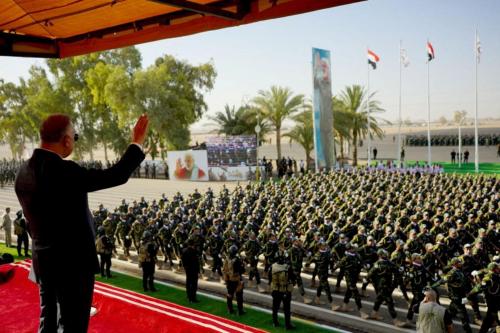In the face of seemingly weekly terrorist attacks and reports that Islamic State affiliates are growing in number, political leaders are under pressure to take tougher action against ISIS and other violent extremist threats. Removing terrorists from the battlefield and from streets remains critical—President Obama announced last week that the United States will send 250 more special operations forces to Syria, for one, and other military, intelligence, and law enforcement efforts will be important. According to one assessment, the United States has spent $6.4 billion on counter-ISIS military operations since August 2014, with an average daily cost of $11.5 million. As a result of these and related efforts, the territory the Islamic State controls has been diminished and its leadership and resources degraded.
The more challenging task, however, may be preventing individuals from joining the Islamic State or future groups in the first place and developing, harnessing, and resourcing a set of tools to achieve this objective. Violent extremism is most likely to take root when communities do not challenge those who seek to radicalize others and can’t offer positive alternatives. Prevention is thus most effectively addressed by the communities themselves—mayors, teachers, social workers, youth, women, religious leaders, and mental health professionals—not national security professionals, let alone national governments. But it’s easier said than done for national governments to empower, train, and resource those communities.
Political leaders around the globe are increasingly highlighting community engagement and the role of communities more broadly in a comprehensive counterterrorism strategy. States, however, continue to struggle with how to operationalize and sustain these elements of the strategy.
Show us the money
First, there is the funding shortfall. Too many national governments continue not to provide local governments and communities with the resources needed to develop tailored community engagement programs to identify early signs of and prevent radicalization to violence. To take just one example of the disparity, the $11.5 million per day the United States spends on its military presence in Iraq is more than the $10 million the Department of Homeland Security was given this year to support grassroots countering violent extremism (CVE) efforts in the United States, and nearly twice as much as the State Department’s Bureau of Counterterrorism received this year to support civil society-led CVE initiatives across the entire globe. Although a growing number of countries are developing national CVE action plans that include roles for local leaders and communities, funding for implementation continues to fall short. Norway and Finland are two notable examples, and the situation in Belgium was well-documented following the March attacks in Brussels.
Prevention is thus most effectively addressed by the communities themselves…not national security professionals, let alone national governments.
At the international level, the Global Community Engagement and Resilience Fund (GCERF)—established in 2014 and modeled on the Global AIDS Fund to enable governments and private entities to support grassroots work to build resilience against violent extremism—has struggled to find adequate funding. GCERF offers a reliable and transparent mechanism to give grants and mentoring to small NGOs without the taint of government funding. Yet, despite the fact that “CVE” has risen to near the top of the global agenda, GCERF has only been able raise some $25 million from 12 donors—none from the private sector—since its September 2014 launch. This includes only $300,000 for a “rapid response fund” to support grassroots projects linked to stemming the flow of fighters to Iraq and Syria—presumably a high priority for the more than 90 countries that have seen their citizens travel to the conflict zone. The GCERF Board just approved more than half of the $25 million to support local projects in communities in the first three pilot countries—Bangladesh, Mali, and Nigeria. GCERF’s global ambitions, let alone its ability to provide funds to help sustain the projects in the three pilots or to support work in the next tranche of countries (Burma, Kenya, and Kosovo) are in jeopardy unless donors pony up more resources to support the kind approach—involving governments, civil society, and the private sector—that is likely needed to make progress on prevention over the long-term.
Go grassroots
Second, national governments struggle with how best to involve cities and local communities. Governments still have a traditional view of national security emanating from the capital. Although a growing number of governments are encouraging, and in some cases providing, some resources to support city- or community-led CVE programs, they have generally been reluctant to really bring sub-national actors into conversations about how to address security challenges. Some capitals, primarily in Western Europe, have created national-level CVE task forces with a wide range of voices. Others, like the United States, have stuck with a model that is limited to national government—and primarily law enforcement—agencies, thus complicating efforts to involve and build durable partnerships with the local actors, whether mayors, community leaders, social workers, or mental health officials, that are so critical to prevention efforts.
Some members of the target communities remain skeptical of government-led CVE initiatives, sometimes believing them to be a ruse for intelligence gathering or having the effect of stigmatizing and stereotyping certain communities. As debates around the FBI’s Shared Responsibilities Committees show, there are high levels of mistrust between the government—particularly law enforcement—and local communities. This can complicate efforts to roll out even well-intentioned government-led programs aimed at involving community actors in efforts to prevent young people from joining the Islamic State. The trouble is, communities are largely dependent on government support for training and programming in this area (with a few exceptions).
To their credit, governments increasingly recognize that they—particularly at the national level—are not the most credible CVE actors, whether on- or off-line, within the often marginalized communities they are trying to reach. They’re placing greater emphasis on identifying and supporting more credible local partners, instead, and trying to get out of the way.
Invest now, see dividends later
On the positive side of the ledger, even with the limited resources available, new (albeit small-scale) grassroots initiatives have been developed in cities ranging from Mombasa to Maiduguri and Denver to Dakar. These are aimed at building trust between local police and marginalized groups, creating positive alternatives for youth who are being targeted by terrorist propaganda, or otherwise building the resilience of the community to resist the siren call of violent extremism.
Perhaps even more promising, new prevention-focused CVE networks designed to connect and empower sub-national actors—often with funds, but not instructions, from Western donors—are now in place. These platforms can pool limited resources and focus on connecting and training the growing number of young people and women working in this area; the local researchers focused on understanding local drivers of violent extremism and what has worked to stem its tide in particular communities; and mayors across the world who will gather next month for the first global Strong Cities Network summit. Much like GCERF, these new platforms will require long-term funding—ideally from governments, foundations, and the private sector—to survive and deliver on their potential.
Somewhat paradoxically, while the United States (working closely with allies) has been at the forefront of efforts to develop and resource these platforms overseas and to recognize the limits of a top-down approach driven by national governments, similar innovations have yet to take root at home. More funding and innovation, both home and abroad, can make a huge difference. For example, it could lead to more community-led counter-narrative, skills-building, or counselling programs for young people at risk of joining the Islamic State. It could also help build trust between local police and the communities they are meant to serve, lead to more training of mainstream religious leaders on how to use social media to reach marginalized youth, as well as empower young filmmakers to engage their peers about the dangers of violent extremism. And national prevention networks that aren’t limited to just government officials can help support and mentor communities looking to develop prevention or intervention programs that take local sensitivities into account. Without this kind of rigorous effort, the large sums spent on defeating terrorism will not pay the dividends that are badly needed.
The Brookings Institution is committed to quality, independence, and impact.
We are supported by a diverse array of funders. In line with our values and policies, each Brookings publication represents the sole views of its author(s).



Commentary
Investing in prevention: An ounce of CVE or a pound of counterterrorism?
May 6, 2016